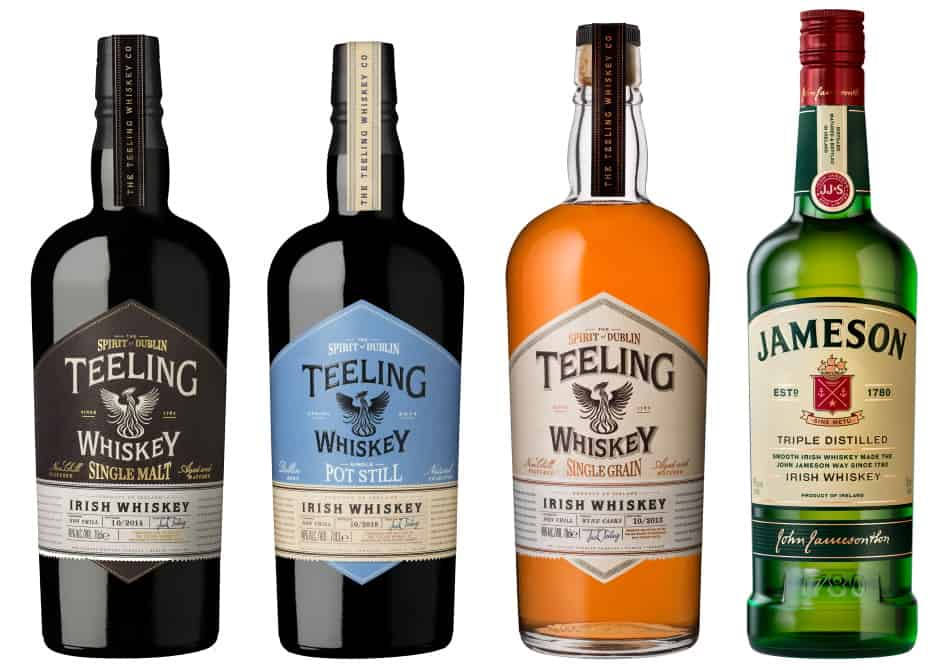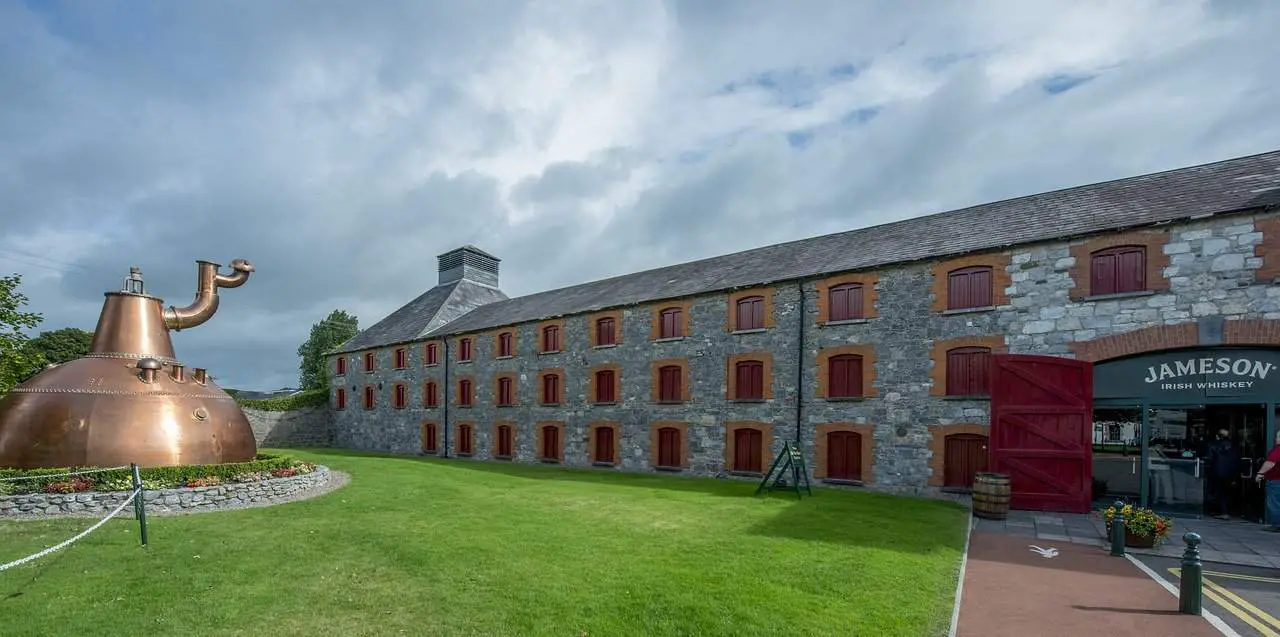Ireland has been making whiskey for hundreds of years and is one the biggest whiskey producing countries in the world. With so many Irish whiskeys out there, it can be difficult to know where to start. Fortunately, there are only four types of Irish whiskey which makes thing a lot easier.

1. Single Malt Irish Whiskey
The first type of Irish whiskey is single malt which has three criteria:
- It must be made from malted barley only.
- It must be distilled in a pot still.
- It must come from one distillery.
Distillate produced by malted barley has a better flavor profile than the distillate produced by other grains, even if they’re malted. It’s sweet and tastes of caramel, toffee and brown sugar. Pot stills also produce a more flavored distillate than column stills, and it allows for several different designs which distilleries can use to affect the whiskey’s flavors.
It’s no wonder then, that single malt Irish whiskeys are a category of their own.
Other aspects of single malt Irish whiskey are that they can be peated or unpeated (although they’re typically unpeated), and that they’re often distilled three times which is why they’re so smooth.
Single malt Irish whiskey must also meet all the general criteria for being Irish whiskey (single malt or otherwise):
- It must be made in Ireland.
- It must be aged in used oak barrels.
- It must be aged for at least three years.
- It must be bottled at a minimum of 40%ABV.
Other countries also produce single malt whiskeys which can be confusing because while sometimes that means it’s the same type of whiskey just made in another country, other times it can mean something very different.
Single malt Scotch whiskies do have the same criteria as single malt Irish whiskeys (with the exception that they have to be made in Scotland) whereas American single malt whiskeys need only contain 51% malted barley and don’t have to be made in a pot still. (And like most types of American whiskeys they must be aged in new and not used, charred oak barrels).
Some examples of single malt Irish whiskey are:
- The Irishman Single Malt
- Teeling Single Malt
- The Sexton Single Malt
- Bushmills 21 Year Old
- Tullamore D.E.W. 14 Year Old Single Malt
- The Quiet Man 8 Year Old
- Dingle Single Malt
- Connemara Peated
2. Single Pot Still Whiskey
The second type of Irish whiskey is single pot still whiskey which has the following criteria:
- It must be made from a combination of malted barley, unmalted barley, and other unmalted grains.
- It must be made with a minimum of 30% malted barley and 30% unmalted barley.
- It must be made with a maximum of 5% of other unmalted grains.
- It must be distilled in a pot still.
- It must come from one distillery.
Like single malt Irish whiskeys, pot still whiskeys are also usually distilled three times and they also have to meet all the general criteria for being Irish whiskey which, once again, are:
- It must be made in Ireland.
- It must be aged in used oak barrels.
- It must be aged for at least three years.
- It must be bottled at a minimum of 40%ABV.
As you can see, pot still whiskey is very similar to single malt Irish whiskey and the only real difference between the two is the inclusion of unmalted barley which gives it a distinctive spiciness and thicker texture or creamy mouthfeel, that single malt Irish whiskeys don’t have.
Single pot still whiskeys were the most common type of Irish whiskey until the emergence of blends (see number 4) in the 20th century, although then they were often called ‘pure pot still whiskey’ or ‘Irish pot still whiskey’.
No other whiskey producing country makes pot still whiskey so there’s no possibility of confusing different types of pot still whiskey from different countries. This type of whiskey is unique to Ireland because it was created as a way to get out of a tax that the British had imposed on malted barley.
Some examples of single pot still whiskey are:
- Redbreast 12 Year Old
- Green Spot Single Pot Still
- Midleton Method and Madness Single Pot Still
- Yellow Spot 12 Year Old
- Teeling Single Pot Still
- Drumshanbo Single Pot Still

3. Grain Whiskey
The third type of Irish whiskey is grain whiskey which has two criteria:
- It must be made from a mixed mash of no more than 30% malted barley.
- It must be distilled in a column / continuous still.
The most common grains used for making grain whiskey are maize, rye and wheat, which produces a distillate that’s lighter and more neutral in taste than malted barley. Some malted barley is usually included in the mash bill as they produce a lot of the enzymes used to convert the starches into sugars during the mashing stage of the whiskey making process.
Column or continuous stills produce a distillate with a higher ABV and therefore less flavor – this is not so bad since, as mentioned, they have less flavor to start off with. That’s why the majority of grain whiskey is used for blending with malt or pot still whiskey (see next section). The relative lightness of the clearer, more-neutral-flavored grain whiskey smooths out some of the harsher characteristics in the malt or pot still whiskey.
The other reason grain whiskeys are primarily used for blending is because they’re cheaper to produce than malt and pot still whiskeys and will bring down the price of whatever whiskey they’re blended with. This doesn’t necessarily mean that a cheap blend with a lot of grain whiskey will have little flavor, because sometimes several grain whiskeys are added which together have enough flavors to compete with a single malt.
If a grain whiskey is not used in a blend and if it’s made in one distillery, then it will be called single grain whiskey. Of course, grain whiskey also has to meet all the general criteria for being Irish whiskey.
Other countries also produce grain whiskeys, and once again, they can be similar or very different to Irish grain whiskey.
Grain whisky made in Scotland is similar to Irish grain whiskey. It’s defined as ’any whisky that’s not made from 100% malted barley’ which is similar to the definition of Irish grain whiskey which is defined as ’a mixed mash of no more than 30% malted barley’. The more complicated wording for Irish grain whiskey is necessary because otherwise pot still whiskey would fall into the category of grain whiskey and not be a distinct type of Irish whiskey of its own.
Grain whiskeys made in America, however, are completely different to Irish grain whiskeys. There are several different types of American grain whiskey, and they must be made from a certain amount of that particular grain. Rye whiskey must be made from mash that’s at least 51% rye, wheat whiskey must be made from a mash that’s at least 51% wheat and corn whiskey must be made from a mash that’s at least 80% (not a mistake) corn.
Some examples of Irish grain whiskey are:
- Teeling Single Grain
- Good Times 8 Year Old Irish Single Grain Whiskey
- Glendalough Double Barrel Irish Whiskey
- Kirker & Greer 10 Year Old Single Grain
- Kilbeggan 8 Year Old Single Grain
- Egan’s Vintage Grain
- Greenore 15 Year Old
4. Blended Irish Whiskey
The fourth type of Irish whiskey is blended Irish whiskey which is simply a mixture of the other types of Irish whiskey. And that includes all the ways of mixing them:
- Single malt Irish whiskey with pot still whiskey.
- Single malt Irish whiskey with grain whiskey.
- Pot still whiskey with grain whiskey.
- Single malt Irish whiskey, pot still whiskey and grain whiskey.
As mentioned, blending makes whiskey cheaper but it also allows brands to create whiskeys with the flavors they want. Combining whiskeys of their choosing in precise formulaic proportions, allows brands to create a unique whiskey with a definite and recognizable character.
The difference between blended Irish whiskeys and blended Scotch whiskies is that blended Irish whiskeys can contain an extra type of whiskey (pot still) in their blend. The difference between blended Irish whiskeys and blended American whiskeys is that blended American whiskeys can also contain neutral spirits.
Some examples of blended Irish whiskey (and which types of Irish whiskey they include) are:
- Jameson Irish Whiskey (a blend of pot still and grain whiskeys)
- Bushmills Original (a blend of single malt and grain whiskeys)
- Kilbeggan (a blend of malt and grain whiskeys)
- The Quiet Man Blend (a blend of single malt and single pot still whiskeys)
- Powers Gold Label (a blend of pot still and grain whiskeys)
- Proper No. Twelve (a blend of single malt and grain whiskeys)
- Feckin Irish Whiskey (a blend of malt and grain whiskeys)
- Tullamore D.E.W. (a blend of malt, grain and single pot still whiskeys)

